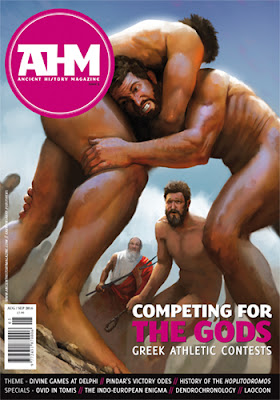30 Jun 2016
Ancient History magazine 5, 30 June 2016
Competing for the Gods
The museum piece: Jona Lendering, "The Lacoon group - Agony"
The Laocoon Group in the Vatican Museums is one of the most famous pieces of sculpture from the ancient world. As a cultural icon, it is only comparable to the golden mask of Tutanchamun, the Venus of Milo, and the Dying Gaul. However, in spite of the statue’s fame, there are still unsolved riddles.
Special: Andrei Pogăciaş, "Ovid in exile - Between arrows and ice"
One of the most famous Latin poets of Antiquity is Publius Ovidius Naso, or Ovid, for short. Although he was the author of many works, he is best known for the masterpieces written in the final, most bitter years at the end his life, spent in exile at the edge of the Roman world, in Tomis, a port on the Black Sea.
Theme: Murray Dahm, "The Four Crown Games - Competing for the Gods"
Thinking of the Olympic Games, we think of the world’s top athletes vying with one another for gold. These ideas, however, have little to do with the original games. The sheer variety of competitions in ancient games reveals that something different was at play in these festivals.
Athtletes had to ritually purify themselves before taking part in the Pythian Games. The place was called Castalia, and here we see the men washing their hair.Theme: Sidney E. Dean, "The origins of the Pythian Games - Victory Laps"
The Pythian Games were held at Delphi in the middle between two Olympic Games. They were formally introduced in 586 or 582 BC. While the Olympic Games honored the Greek pantheon in general and Zeus in particular, the Pythian competition was dedicated to Apollo, patron deity of Delphi and its oracle. The games themselves commemorated Apollo’s victory over the dragon Python and the god’s conquest of Delphi.
Theme: Gareth Williams, "Pindar's victory odes - Second to none?"
The lyric poet Pindar of Thebes (c.518-c.438) was renowned for his epinicia, complex poetic compositions celebrating the triumphs of various athletes who had contested at the major Panhellenic Crown Games. It is alleged that Pindar attended the Pythian Games at Delphi in 490. What can we learn about those competitions from Pindar’s victory odes and other ancient writers?
Theme: Jordan Henderson, "Theagenes of Thasos and Kleitomachos of Thebes - Isthmian Brawlers"
Although each of the great Panhellenic games was dedicated to a different god, it has been said that the gods who were truly honored were the athletes themselves. As the popularity of the games grew, so did the esteem in which their athletes were held. Though they remain long forgotten by most people today, in their own time, they were heroes, lauded for their strength, endurance, unbelievable feats, and of course their physique, immortalized in the construction of statues in their honor.
The author wearing the crested helmet during the first official hoplitodromos reconstruction at the ancient stadium of Nemea in August 2008.Theme: Stefanos Skarmintzos, "Reconstructing the armed race of Nemea - The hoplite race"
The hoplite race was an exhausting and spectacular event during the ancient Greek athletic festivals. In 2006-2010, archaeologists and re-enactors have rediscovered how and why.
Theme: Manolis Peponas, "An inscription from Rhodes - A look at local competitions"
Our literary sources focus on the world of the elite, but inscriptions help us understand the lives of other people. A text from Rhodes documents a local family’s pride in two victories in the local games.
Theme: Nicola Bergamo, "The Olympian Games of Antioch"
The Greek passion for athletics did not end after the Hellenistic Age. On the contrary, having accepted Roman contestants, the Crown Games survived for some four centuries, while other contests were still organized in Byzantine Antioch, for example, the proud capital of Syria and the Roman Near East.
Special: Boed Marres, "The first fruits of DNA-research - A new window on antiquity"
For centuries, our knowledge of Antiquity was based on three types of evidence: ancient texts, studied by philologists; ancient artifacts, which are the archaeologists’ domain; and comparison with other preindustrial societies, studied by anthropologists. Over the past thirty years, a fourth approach has come into being: the study of DNA.
At the end of the fourth millennium BC, Yamnaya people migrated to the Danube basin, taking with them their custom of erecting steles, probably to commemorate their ancestors. These steles can be found all over southern Europe and along the Atlantic shores. This one was found near Nevsha in northeastern Bulgaria and can be seen in the Archaeological Museum of Varna.Special: Marc G. DeSantis, "Puzzling over the Indo-European enigma"
For some two centuries, linguists and archaeologists have been trying to establish the homeland of the first speakers of Indo-European, the common ancestor of Indian, Persian, Greek, Latin, Celtic, and Germanic languages. On the basis of vocabulary and archaeology, several candidates for the homeland were put forward. The analysis of ancient DNA now appears to finally solve the problem.
Philosophy: Kees Alders, "A competition on soberness - The philosophy of Zeno"
The conquests of Alexander the Great profoundly changed the Greek world. The old dichotomy between the independent Greek city-states and the eastern world empires ceased to be relevant. People were citizens of a common world. The world view changed, and hence philosophy, as we see in our series on Hellenistic philosophy. In this issue: Zeno the Stoic.
How do they know?: Christian Koepfer, "How do we know - How to date ancient wood?"
One of the most famous, accurate, and important archaeological methods is dendrochronology: dating ancient pieces of wood by counting tree rings. The principle is simple, but there are some complications.
Ancient History Magazine
Subscribe to:
Post Comments (Atom)

No comments:
Post a Comment